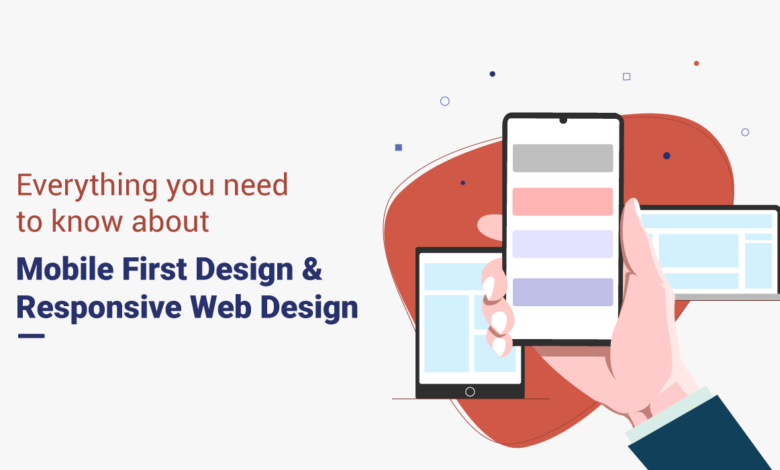A Guide to Mobile-First Design Approach

In today’s digital landscape, mobile devices have become the primary means of internet access for a large portion of the population. So, providing optimal user experiences has become crucial in web design for Melbourne businesses.
To achieve this feat, web designers adopt a mobile-first design approach. This strategy involves designing websites and applications for mobile devices first, then scaling up to accommodate larger screens.
Here are the benefits and principles of mobile-first design and practical tips to help you implement this approach successfully.
I. Understanding the Mobile-First Design Philosophy
The mobile-first design philosophy prioritises the mobile user experience when creating websites or applications. It recognises that mobile devices have become the primary means of internet access for many users.
By adopting this mindset, designers ensure their designs are optimised for smaller screens, touch interactions, and limited bandwidth. Mobile-first design involves starting with the essentials and progressively enhancing the design for larger screens.
This approach enables designers to create intuitive, responsive, and performance-driven experiences that cater to the needs of mobile users.
II. Critical Benefits of Mobile-First Design
- Improved Performance: Mobile-first design forces designers to prioritise essential content and optimise performance, resulting in faster load times and improved overall performance.
- Enhanced User Experience: By focusing on mobile devices, you can create user-friendly interfaces that adapt to smaller screens, providing intuitive navigation and seamless interactions.
- Better Conversion Rates: As mobile users grow, designing with their needs in mind increases the likelihood of conversions and engagement.
III. Mobile-First Design Principles
- Content Prioritisation: Start by identifying the core content and features crucial for mobile users. Streamline the design to provide a concise and efficient experience on smaller screens.
- Responsive Design: Use responsive design techniques to ensure the web design for your Melbourne business scales and adapts gracefully across different devices and screen sizes.
- Touch-Friendly Interactions: Consider the touch-centric nature of mobile devices and design for easy tapping, swiping, and scrolling. Provide ample space between elements to prevent accidental clicks.
- Progressive Enhancement: Begin with a solid foundation for mobile devices and then add enhanced features and layouts for larger screens.
- Simplified Navigation: Mobile screens have limited space, so prioritise simplicity in navigation by using collapsible menus, hamburger icons, or slide-out panels.
- Optimised Typography: Choose fonts and font sizes that are legible on smaller screens. Pay attention to line lengths and spacing to enhance readability.
- Performance Optimisation: Optimise images, reduce HTTP requests, and minify code to improve loading times and ensure a smooth user experience.
IV. Practical Tips for Mobile-First Design
- Conduct Mobile Research: Understand your target audience’s mobile behaviours, preferences, and devices. This insight will inform your design decisions.
- Design with a Mobile Emulator: Use mobile emulators or tools to preview and test your design on various devices and screen sizes.
- Content-First Approach: Craft your content strategy before designing, ensuring it fits seamlessly within a mobile context. Prioritise essential information and consider the user’s goals.
- Mobile-Friendly Forms: Optimise form inputs for touch input and provide clear instructions and feedback to enhance the user’s form-filling experience.
- Performance Optimisation Techniques: Compress and resize images, use lazy loading, and minimise the use of external scripts to optimise performance.
- User Testing and Iteration: Regularly test your design on real mobile devices, gather feedback, and make iterative improvements to enhance usability and address issues.
V. Other Aspects to Consider in Mobile-First Designs
In addition to the points mentioned earlier, here are a few more aspects to consider when understanding the mobile-first design philosophy:
- Mobile Context: Recognise the unique context in which mobile users interact with websites or applications. Mobile devices are often used on the go, in various environments, and with different levels of distractions—design with these factors in mind to ensure a seamless and distraction-free experience.
- Limited Screen Real Estate: Mobile screens have limited space compared to desktop monitors. Designers must prioritise content and features that are most important for mobile users, ensuring they are easily accessible and prominently displayed within the constraints of smaller screens.
- Touch Gestures: Mobile devices rely heavily on touch gestures for navigation and interaction. Incorporate touch-friendly design elements such as large buttons, spacious tap targets, and intuitive swipe gestures to facilitate smooth and effortless interactions.
- Performance Optimisation: Mobile networks can be slower and less stable than fixed broadband connections. Optimise your design for performance by minimising file sizes, reducing HTTP requests, and leveraging caching techniques to ensure quick and efficient loading times on mobile devices.
- Progressive Enhancement: Start with a solid foundation for mobile devices and then enhance the design for larger screens and more capable devices. This approach allows for the graceful degradation of features and ensures the core functionality remains intact across all devices.
- Device Compatibility: A wide range of mobile devices have different screen sizes, resolutions, and capabilities. Design with responsiveness in mind to ensure that your website or application adapts and functions well on various devices, from smartphones to tablets.
- User Research: Conduct thorough research on your target audience to understand their mobile behaviours, preferences, and goals. This insight will inform your design decisions and enable you to create experiences that align with their needs and expectations.
Conclusion
Embracing a mobile-first design approach is no longer an option but necessary in today’s mobile-centric world. By designing for mobile devices first, you prioritise the needs and expectations of most users. This approach leads to improved performance, enhanced user experiences, and higher conversion rates.
Lastly, choosing the right professional is crucial for these mobile-first designs. If we may, we recommend Make My website for pursuing your web design projects. The experts at MMW have incredible skills and attention to detail.
Apart from web designing, MMW also offer several other important digital services, such as content creation and SEO services in Melbourne. So, we encourage you to check out MMW’s official website to ensure you are making the right decision.



